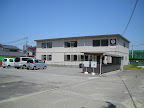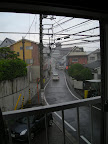Sorry for the delay. Because I don’t have my own internet access, I never know for sure when I’m going to be able to get online, and this last week added a couple new wrinkles.

Before I go any further, here’s a picture of the government building I visit to get online. You might notice two things about this picture of the Ehime Prefecture International Center (EPIC) that are pretty typical in Japan- there’s parking for more bicycles than cars, and that parking is covered, while the automobile parking spaces are not.
First of all, we had some serious rain on Tuesday. Sometimes in Las Vegas, it rains buckets of water but it only lasts for a few minutes at a time. It occasionally lasts an hour or two, and ends up washing away roads in Summerlin or floating cars through the Charleston underpass. I’m not sure if the typhoon off the eastern coast of Japan pushed it our way or what, but it rained like that here on Tuesday. In fact, I chose not to ride through that rain to EPIC to use their computers.
I thought when it started raining like that in the morning I thought I’d be safe by the time I had to ride my bike to work at 3pm, but that turned out to just be wishful thinking. Steering my bike with one hand and holding my umbrella with the other, I hadn’t ridden 50 feet before I could feel rivulets of water running down my back under my dress shirt. Luckily, I had almost a whole hour to dry off before my first lesson (I was still a bit damp). Incidentally, it stopped raining at about 4pm. Go figure.

I used to think that the huge washes and moat-like gutters lining the sidewalks here were overkill, or perhaps holdovers from irrigation channels when this area was farmland, but now I see that they serve a real purpose. Lest you think I’m exaggerating the rainfall, here’s a picture I took from one of the windows in my apartment. It may look like dusk, but I took it just before I left for work at 3:00. I’m not sure if you’ll be able to see it on the web, but in the full resolution version you can see coherent streams of water, as if poured from a thousand buckets. I can’t wait for the rainy season to start in a couple of months.
The other new wrinkle is a previously unscheduled student added to the front of my schedule. Instead of the 2 or 4 pm I’ve been used to, I’ve had to be at work at 1:30 every day this week, which gives me less time to ride downtown and use a computer before work.
But perhaps I’m getting ahead of myself.
Despite all my nervousness, my trip to Matsuyama was pretty straightforward. In fact, I was so prepared for one of the many pieces to fall out of place that it was almost a let-down. Buying a ticket for the monorail was a bit sketchy at first when the machine wouldn’t take my money, but I soon figured that you had to put the coins in from high to low denominations. I was also a little unsure of what to do when they were announcing boarding groups for the airborne segment of my trip and I couldn’t understand a word of what was said, but I just waited for what seemed like general coach-class boarding, and got on with everyone else for the half-full flight from Tokyo to Matsuyama. The Japanese transportation system lived up to its clockwork reputation, and I figured out what I was supposed to do through context clues and the occasional English label.
In Matsuyama, I was supposed to catch a “limousine†bus from the airport to Matsuyama station where I’d be picked up by a school employee. Instead, I was met by the school’s owner at the airport. I had no idea he would be there, but it was quite easy for him to call me out of the otherwise entirely Japanese crowd.
As we drove away from the airport, the first thing I noticed about Matsuyama was how clear the sky was and how much it reminded me of southern California. We followed Ishite River for a while, then drove through the downtown area and this cute walking street shopping district, and ended up on the street where the school is situated. Except for the fact that everything is in Japanese, it really could be San Diego.

Here’s a picture of my school and the building that houses it.
Teshima-san (the aforementioned owner) picked up Semba-san (the school’s manager) from school, and the three of us ate lunch at Bamiyan Chinese restaurant (think Applebee’s with pork fried rice) near the school while getting acquainted. Teshima-san is a busy man, almost never seen at school. Semba-san is also quite busy, but in contrast with Mr. Teshima, Ms. Semba’s life seems to revolve around the school. She preps the school to open every day at 2pm, and sometimes doesn’t leave until after 11pm.
After lunch, she drove me over to my new apartment to meet Erin Kourelis, the outgoing teacher I was hired to replace. Erin had checked out an extra bicycle from EPIC, and after I unceremoniously dropped my bags near the genkan (ã’ã‚“ã‹ã‚“ – shoe-changing entrance area) by the front door, we rode around the neighborhood in the waning light to acquaint me with the environ and shop for dinner fixin’s.
That night, as we talked over beef curry and rice, I got an idea of how much I had to absorb from Erin in the next three days until he left for New York.
I was to have about fifty students, spread over about twenty classes per week. Of those twenty classes, there are three pairs of classes with matching syllabi and lesson plans. Minus those, I was looking at preparing lesson plans and materials for about seventeen individual classes of varying age and ability levels each week. Oh. Okay.
When I was riding around the neighborhood and shopping with Erin, I didn’t see as much English as I had seen in the area around Tokyo. I wasn’t entirely surprised, but I need at least some English to make basic shopping and restaurant menu decisions. Erin’s lived in various Japanese cities for six years and learned quite a bit of Japanese, so it was basically a nonissue for him, but he agreed with my assessment, saying that Matsuyama is “pretty bad for English.†Oh. Okay.
Another thing I realized while riding around is that Las Vegas and its grid pattern are very easy to navigate. Matsuyama is laid out in typical “confuse the invading armies†Japanese style. So… Hey great, you have a map! Is there one with our neighborhood? No? Is there an English map of the city? No? Oh. Okay.
This last point proved to be an important issue.